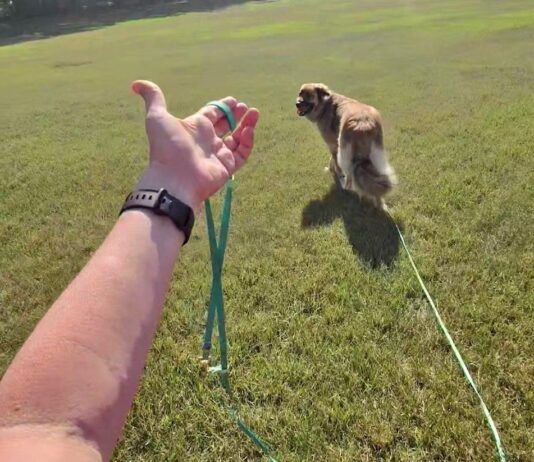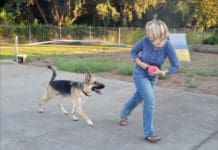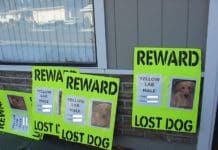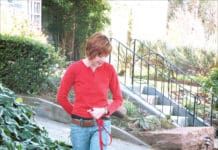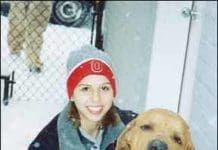5 Things To Do If Your Dog Won’t Come to You
It's frustrating at best, dangerous at worst, when you can't get your dog to come to you. Indoors, he may be suspicious that you're going to do something aversive, such as treat his ear infection, or put him in his crate. Outdoors, he may also have an aversive association with coming to you, or he may just be having entirely too much fun. Whatever the cause, here are five tips for handling the crisis:
How to Catch a Dog on the Loose
but most will send an officer right away if the dog is contained."
9 Expert Tips for Walking Your Own Dogs
Use good equipment that is appropriate for your dog (for example, if not well trained, giant dogs probably need more than a flat collar and retractable leashes are not considered safe, ever). Inspect the fit and condition of all your equipment frequently. Ensure that your dog wears a tag with current information.
Fitness Together
I confess: I have a hard time fitting in enough exercise for myself and my dog. Nothing earth-shattering about this admission; I think not getting enough exercise is a universal condition. Even though my dog and I walk daily, life and age just keep creeping up, making it harder and harder for me to stay fit. And, my high-energy herding dog seems to always need just a little more in the way of activity than I have time and energy to provide.
Some Quick Tips for Loose Leash Walking
Joan Morse, CPDT-KA, CA-P1, CNWI, of Tailwaggers Canine Campus in Newark, Delaware, recommends Leslie McDevitt’s “Pattern Games” when teaching loose-leash walking. She describes one of those games: “The Two Step: drop a treat on the ground. Take two steps forward while the dog eats the treat. The moment he looks up at you, click, drop another treat right by you and take two more steps. This game develops a pattern or rhythm for the dog that will keep his attention on the handler and keep him moving as she moves. You usually get a nice loose leash walk quickly.”
How to Teach Loose Leash Walking to Your Dog
with the treats delivered right at her side
Training Your Dog to Execute an “Extremely Fast” Reliable Recall
having students compete for the fastest recall in heat after heat
A Strong Recall is Critical During Your Dog’s Water Play
No matter how strong your dog’s recall may be (and we recommend it be quite strong if you’re considering letting your dog off-leash at the beach, lake, or river), it’s important to remember that the excitement of being in the water, coupled with the potential desire to swim out for a toy or chase a flock of ducks, could result in his recall falling on deaf ears. Prior to fun water play, consider brushing up on your dog’s recall with the following...
Selecting the Correct Leash Length for Your Various Leash Training Exercises
When you think “leash,” chances are you think of a four-to-six-foot strap made of nylon, cotton, hemp, leather, or (horrors!) chain, with a snap that attaches to your dog’s collar at one end and a handle for you to hold at the other. You use it to keep him close to you when you take him for walks or other places where he has to be under control. But a leash can be so much more than that! Let’s think outside the box. There’s no law that says leashes have to be a certain length, made of a particular material, or be limited to one snap and one handle. There are all kinds of things you can do with non-traditional leashes. Heck, there’s even a good use for the grocery store chain leash.
On-Leash Training Blossoming into Off-Leash Reliability
The transition from on-leash training to off-leash reliability can be a frustrating challenge. “But he knows what ‘come’ means!” a client wails, and points as proof to the fact her dog comes impeccably, every time, when called in the training center, the house, or the backyard. Her dog does know what come means – in the training center, in the house, and in the backyard. He also knows that when he’s hiking in the woods, chasing squirrels and rabbits is far more rewarding than coming back when he is called, especially since “Come” often means “The hike is over, the leash is going on the collar, and we’re returning to the car.”
How to Train Proper Leash Walking – Pull Over!
One of the more frustrating experiences for positive dog trainers is watching their clients being dragged by their dogs across the parking lot toward their cars, just moments after training class is dismissed. “Dang,” we sometimes think, “Will they ever teach their dogs to walk politely on-leash? What part of ‘Don’t reinforce your dog for pulling!’ didn’t they hear?” Of course, it’s equally frustrating for dog owners when their dogs drag them. And the training solution – stopping every time the dog pulls – gets tiresome.
When Your Dog Refuses To Walk On A Leash
It’s frustrating and embarrassing when your dog puts on the brakes and refuses to move. If he’s small you can pick him up and carry him; although that might not be the best training solution, at least it gets you out of there and you can save face. But what if it’s a Great Dane, a Newfoundland, or any breed – or combination of breeds – that’s too big to be portable?


